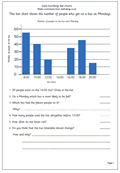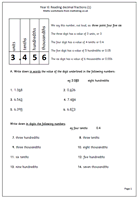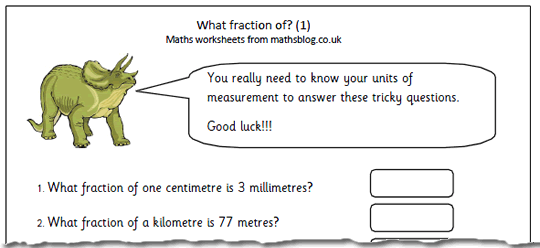 The latest Ofsted figures show that more schools are being judged as inadequate. In 2008/9 the proportion of schools judged as inadequate was 4% but this has more than doubled to 10% this year.
The latest Ofsted figures show that more schools are being judged as inadequate. In 2008/9 the proportion of schools judged as inadequate was 4% but this has more than doubled to 10% this year.
Why? Well, it has more to do with the way Ofsted works than schools actually getting better or worse. Ofsted is concentrating on inspecting schools which have a poor record in the past, so they are not looking at the best schools as often. Outstanding and good schools will only be inspected every 5 years whilst inadequate schools receive regular visits.
Resource of the Week: Year 4 data handling
Most of the worksheets that you see free online are for numbers and calculating, as these are the easiest to produce. However, mathsblog has an excellent range of worksheets across all areas of maths, including data handling. Here is a page on interpreting bar charts, which also uses the 24 hour clock. it is important to point out that charts such as these must have a proper title and that the axes must be labelled. When children produce their own bar charts they often forget to do this labelling.
When looking at a bar chart one of the first things to do is work out how the numbers are being represented. In this case the number of people on the bus is shown in blocks of 10 and half way between would be a block of 5.
Year 2 Time: One minute
Getting a clear concept of amount of time is important for young children. This page challenges children to complete a number of tasks in one minute, such as how tall a tower can be built using blocks/lego etc.
An important part of this is to make sure that they make an estimate/guess before starting which shows how realistic they are about time. This resource can be found in our Year 2 measurement section.
Year 6 maths worksheet: Reading decimal fractions
By Year 6 children should have a good understanding of place value, including decimals. Decimal fractions are often best taught in the context of money, but this only covers tenths and hundredths. This maths worksheet looks at thousandths as well. There two main parts: firstly, writing the value of decimal fractions in words and secondly, writing decimals in digits using the decimal point correctly.
Just like whole numbers a digit becomes ten times smaller when it is moved one place to the right after the decimal point, so the digit 6 in 0.467 is 6 hundredths and the 6 in 0.356 is 6 thousandths.
Year 6 Maths: Fractions
Carol Vorderman’s maths
Carol Vorderman’s maths
Well, I was hoping to have a look at this but at the moment it is impossible to sign up to Carol Vordeman’s maths site. Too many applicants. Not surprising given that she had a 7 minute free advert on prime time BBC which included talking about her price structure as well as a link on the BBC site to her site. I’m sure all the other companies producing similar maths material, such as Conquer Maths, Whizz maths, Mathsgogogo, MathSphere, URBrainy, 10 Ticks (I could go on!) would like a similar 7 minutes free advertising and links.
Whilst I’m totally in favour of improving maths I do think all these sites should be given equal chances to advertise: but I believe that the BBC are not supposed to advertise.
Coming soon: Fractions, time and calculator activities
 On our year 6 fractions page there are several different sets of skills and knowledge needed. Firstly knowledge of measurements eg that there are 1000 metres in a kilometre, 1000 ml in a litre etc, as well as a couple of Imperial measures thrown in as an extra challenge.
On our year 6 fractions page there are several different sets of skills and knowledge needed. Firstly knowledge of measurements eg that there are 1000 metres in a kilometre, 1000 ml in a litre etc, as well as a couple of Imperial measures thrown in as an extra challenge.
Secondly, to be able to write 600ml as a fraction of 1litre eg 600/1000.
Thirdly to be able to simplify fractions eg 600/1000 is equivalent to 6/10.
Getting a clear concept of amount of time is important for young children. Next week’s page on time challenges children to complete a number of tasks in one minute, such as how tall a tower can be built using blocks/lego etc.
Also coming soon is a calculations game to help with learning the two times table.
Calculator game: 2x table
A good way to reinforce the 2x table is to play this fun game. All you need is the grid, some counters or cubes and a calculator. Set the calculator up as a 2x table answer machine by keying in 2, x, x, =, 0 and then all you need to do is press a number and the equals sign and it will show the answer to the number multiplied by 2. Just type in the next number, press equals and so on…
The aim of the game is to make a line of four in a row in any direction.
Resource of the Week: Year 4 Find a difference
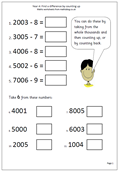 Sometimes a simple question can reveal a great deal about how children deal with numbers. This maths worksheet on finding differences is full of such questions.
Sometimes a simple question can reveal a great deal about how children deal with numbers. This maths worksheet on finding differences is full of such questions.
Let’s look at 3005 – 8 which is easier to do mentally than on paper.
There are several ways that this can be done.
1. Count down, one at a time, 8 from 3005, saying each number as you go. Fingers may be held up on each count down until 8 is reached.
3004, (1), 3003 (2), 3002 (3), 3001 (4), 3000 (5), 2999 (6), 2998 (7), 2997 (8)
2. A different way is to take the 8 from 3000, then add 5.
3000 – 8 = 2992
2992 + 5 = 2997
3. A third way is to take 5 off the 8 leaving 3.
Then take 3 off 3000 = 2997
It is well worth talking to children about how they do this kind of question and what strategies they employ. Much will depend on their knowledge of number.
Year 6 Maths: Fractions
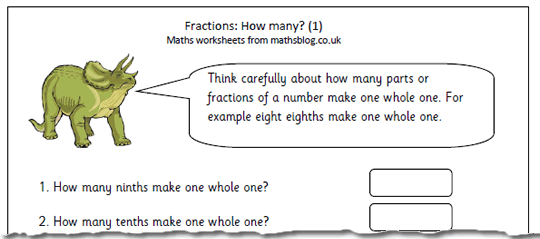 Here we have some quite tricky questions on fractions, suitable for Year 6. The key to these is to think carefully about how many parts or fractions of a number make one whole one and to understand equivalent fractions.
Here we have some quite tricky questions on fractions, suitable for Year 6. The key to these is to think carefully about how many parts or fractions of a number make one whole one and to understand equivalent fractions.
Understanding equivalent fractions is the key to understanding fractions generally and it is a good start to know that ten tenths make one whole one, as do six sixths etc.
